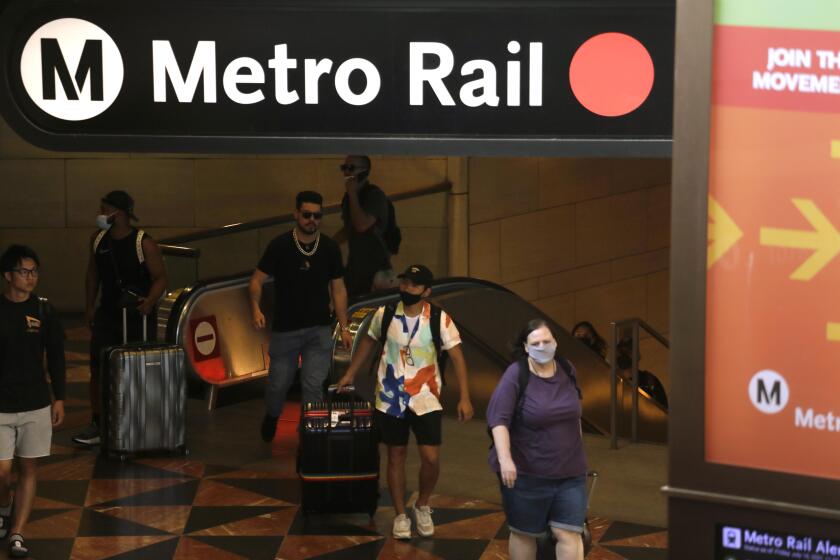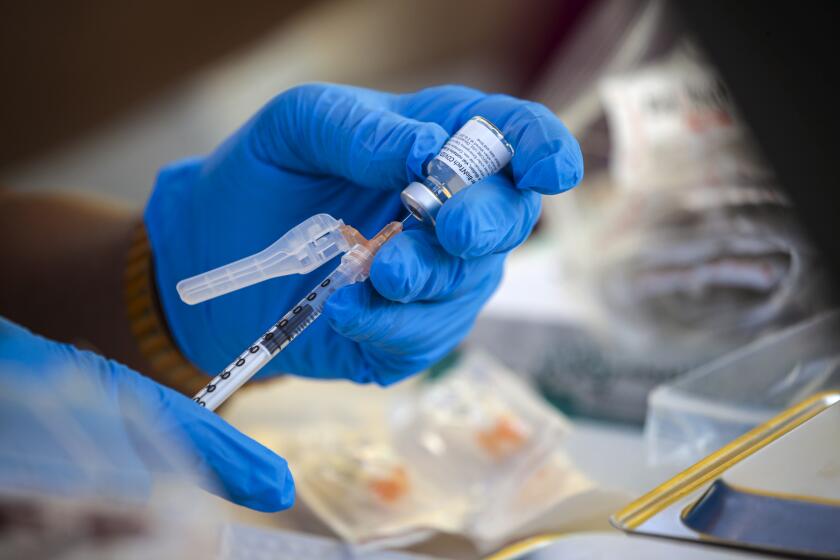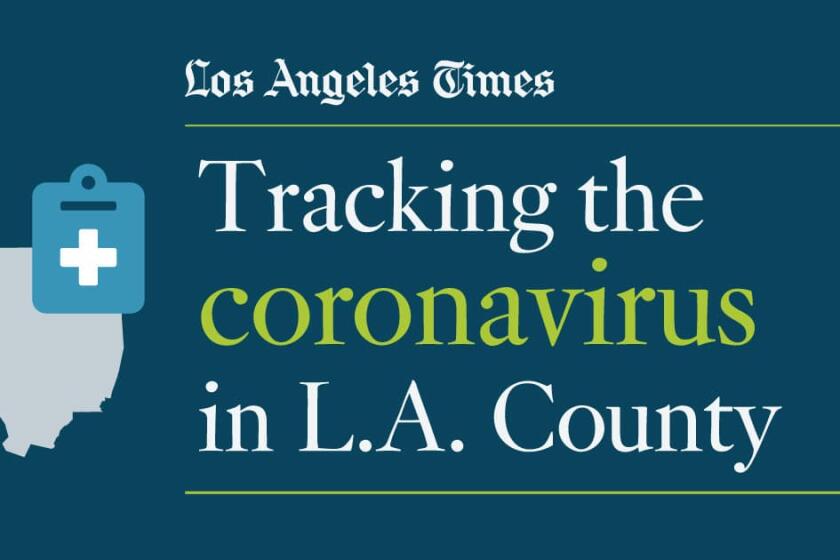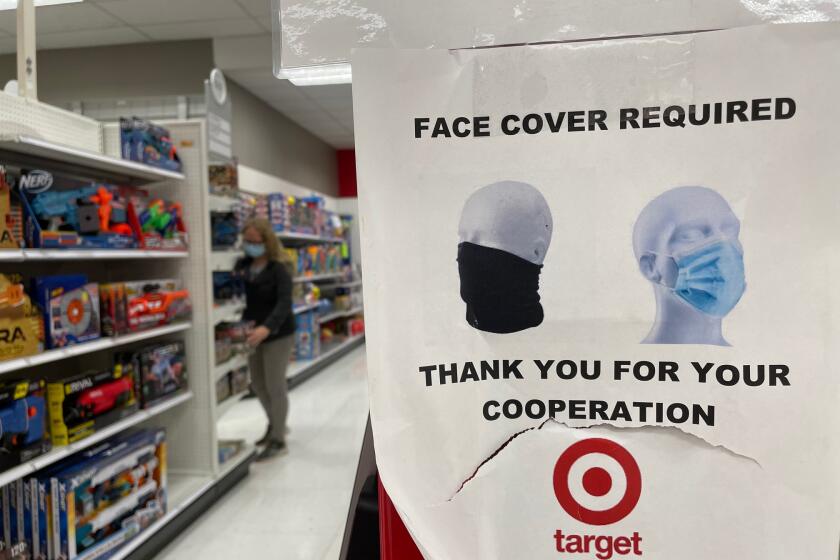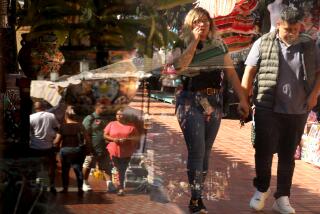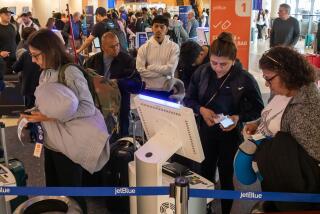Even the vaccinated must take precautions as L.A. coronavirus surge worsens, officials say
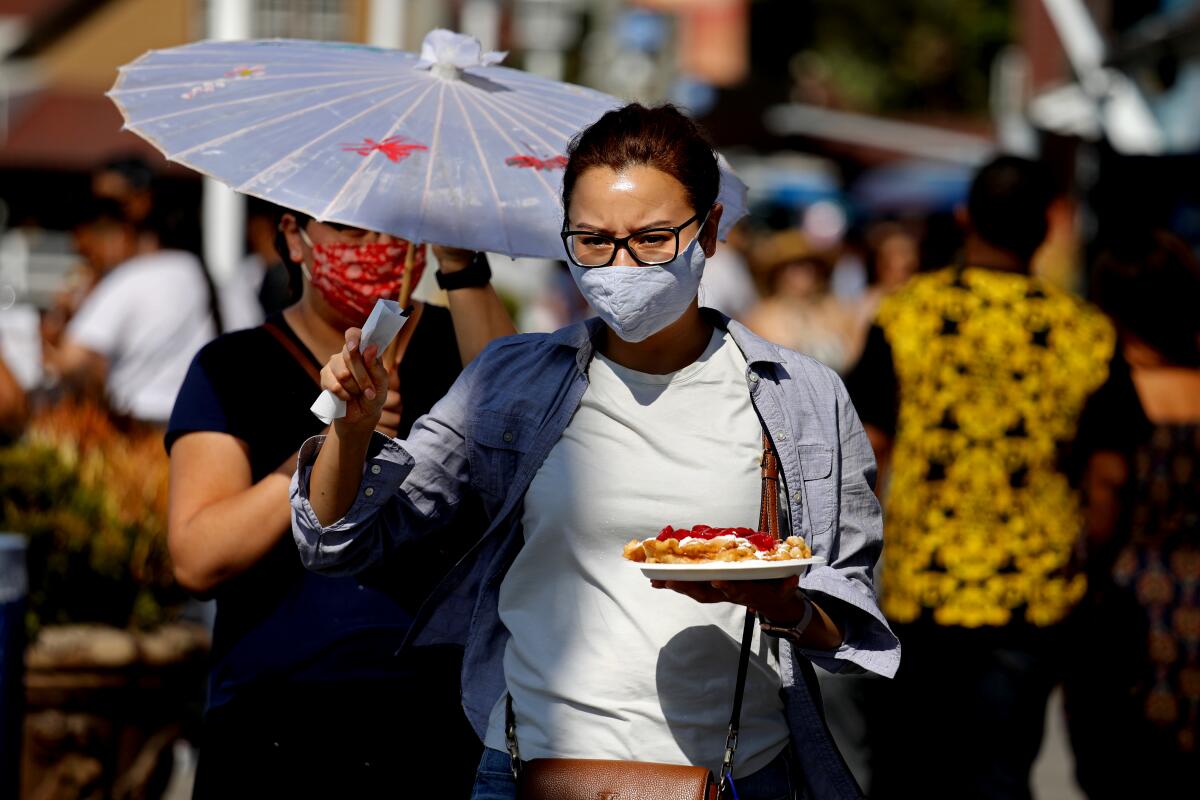
With coronavirus cases reaching levels in Los Angeles County not seen since the waning days of the winter surge, public health officials said Thursday that even those who have been vaccinated should take precautions, given how widely the virus is now circulating.
This surge is predominantly hitting people who have not been vaccinated. But with the highly infectious Delta variant racing through the region, additional measures — like wearing masks inside crowded public places — can further armor everyone against transmission.
“Vaccines are like our umbrella: excellent protection on most rainy days. But when the rain gets really intense, for example during a bad thunderstorm, we might also throw on a raincoat,” said L.A. County Public Health Director Barbara Ferrer.
But, “When you have a more infectious variant that’s circulating and you see what we see now, lots of community transmission, you can expect exactly what we’re seeing: lots more people getting infected, including more people who are fully vaccinated,” she added.
That mathematical reality is now playing out. Out of all coronavirus cases confirmed countywide in June, 20% occurred in residents who were fully vaccinated, according to Ferrer.
The figure is not as alarming as it first appears. At the beginning of June, about 44% of residents were fully vaccinated, with the proportion rising above 50% by the end of the month, according to data compiled by The Times. Currently, 53% of L.A. County residents are fully vaccinated.
In other words, even though half of the county was not fully vaccinated in June, this portion of the county’s residents comprised 4 out of 5 newly diagnosed coronavirus cases.
“While our numbers have been going up, they would be much higher if we didn’t have as many people fully vaccinated,” Ferrer said.
She also noted that, among fully vaccinated infectees, “the vast majority of those folks only experienced either no illness or very mild illness.”
The positivity rate now stands at 5.2% in Los Angeles County, and health officials say that cases have increased twentyfold over the last month.
County health officials reported 2,767 additional cases Thursday, the second straight day with more than 2,000 newly confirmed infections.
COVID-19 hospitalizations are also rising. On Wednesday, 655 coronavirus-positive patients were hospitalized countywide — nearly triple the number seen a month ago.
Despite this, L.A. remains in far better shape than during the fall-and-winter surge, when an average of about 15,000 new cases were being reported every day and more than 8,000 COVID-19 patients were hospitalized at times.
And daily COVID-19 death totals still remain relatively low, at an average of about four in L.A. County and 22 statewide, according to data compiled by The Times.
Ferrer noted that hospitalizations are not yet climbing as steeply as during earlier surges.
“It’s too early to say with 100% certainty whether the small uptick we’re seeing in hospitalizations is the beginning of a small wave of hospitalizations or the start of a more devastating surge,” she said. “We are hopeful, however, that with so many of our highest-risk residents fully vaccinated, we will not see the same rate of increase in hospitalizations that we saw last year.”
As COVID-19 cases rise again in Los Angeles County, people who aren’t vaccinated make up the vast majority of new infections.
A small number of COVID-19 ‘breakthrough’ cases are expected after vaccination, and health officials say they’re not a cause for alarm
During June, those who were not fully vaccinated were infected and hospitalized at roughly five times the rate of fully vaccinated residents, county data show. The COVID-19 death rate was minute for both groups, though still higher for unvaccinated residents.
Cumulatively, out of the more than 4.8 million L.A. County residents who have been fully vaccinated, 6,520 — about .13% — had tested positive.
Only 287 people, roughly .006%, later had to be hospitalized for COVID-19; and 30 people, .0006%, eventually died.
Though officials have long maintained that all of the COVID-19 vaccines available in the United States protect against coronavirus infection, and are particularly effective at staving off serious illness, the new uptick in cases nationwide — as well as circulation of the highly contagious Delta variant — has sparked fresh fears about the potential for even fully inoculated individuals to become sick.
Such “breakthrough” cases are rare, but not unpredicted, experts say.
“Infections after vaccination are expected. No vaccine is 100% effective,” said Dr. Anthony Fauci, the U.S. government’s top infectious-diseases expert. “However, even if a vaccine does not completely protect against infection, it usually, if it’s successful, protects against serious disease.”
While reports of fully vaccinated people occasionally getting the coronavirus may sound alarming, the shots dramatically reduce severe disease and death.
Fauci cited data showing the Pfizer-BioNTech and Moderna vaccines were 95% and 94% effective, respectively, versus symptomatic COVID-19. And in the United States, the single-shot Johnson & Johnson vaccine has been 72% effective against clinically recognizable disease.
“So even though we are seeing infections after vaccination ... the effectiveness against severe disease is still substantial,” he said.
Ferrer employed another metaphor to illustrate the point.
“While seat belts don’t prevent every bad thing that can happen during a car accident, they do provide excellent protection — so much so that we all use them routinely,” she said. “It wouldn’t really make sense to not use a seat belt just because it doesn’t prevent all injuries from car accidents.”
Similarly, she continued, “rejecting a COVID vaccine because they don’t offer 100% protection really ignores the powerful benefits.”
Statewide, officials note that while there are instances of vaccinated people becoming infected, the risk remains much more pronounced for the uninoculated.
Over the week of July 7 to 14, the average case rate among unvaccinated Californians was 13 per 100,000, according to the state Department of Public Health. Among those who had been vaccinated, the comparable figure was 2 per 100,000.
Misinformation about COVID-19 vaccines is costing people their lives. We separate the myths from the reality.
The spread of the coronavirus has increased to such a point that the U.S. Centers for Disease Control and Prevention now considers L.A. County to have “high” community transmission — the worst classification on the agency’s four-tier scale.
Other California counties in that category include Contra Costa, San Joaquin, Stanislaus, Merced, Lake, Sutter, Yuba and Plumas.
L.A. County officials have already intervened to try to break the chain of transmission by reinstituting a requirement for everyone to wear masks in indoor public settings.
However, it will take weeks to assess whether that effort has the desired effect, or whether more aggressive restrictions are necessary.
The surest way to keep that from happening, officials say, is for as many people to get vaccinated as quickly as possible.
The latest maps and charts on the spread of COVID-19 in Los Angeles County, including cases, deaths, closures and restrictions.
Though L.A. County’s indoor mask mandate remains the most expansive in the state, about 60% of Californians now live in a county that either advises or instructs universal face coverings in places like grocery stores, retail outlets, movie theaters and at restaurants when not eating or drinking.
Over the last week, California has reported an average of nearly 5,000 new coronavirus cases a day, five times higher than four weeks ago, according to data compiled by The Times.
In late June, the state was recording about 6,000 new cases a week, a Times analysis shows. But at the peak of the pandemic, California was seeing more than 300,000 new coronavirus cases over a seven-day period.
Despite how cases have climbed throughout California and the nation, neither state nor federal health authorities have walked back their guidance that fully vaccinated residents can go without face coverings nearly everywhere, though unvaccinated people must still mask up in public indoor spaces.
“We don’t have to have masking if we all got vaccinated,” Gov. Gavin Newsom told reporters this week.
One-third of California counties are now urging even fully vaccinated people to wear masks indoors as coronavirus cases continue to rise.
CDC Director Dr. Rochelle Walensky said Thursday that the agency’s recommendations haven’t changed — though she noted that “we’ve always said that communities and individuals need to make the decisions that are right for them based on what’s going on in their local areas.”
“If you’re in an area that has a high case rate and low rates of vaccination, or if Delta cases are rising, you should certainly be wearing a mask if you are unvaccinated,” she said during a briefing. “If you are vaccinated, you get exceptional protection from the vaccines, but you have the opportunity to make the personal choice to add extra layers of protection, if you so choose.”
More to Read
Start your day right
Sign up for Essential California for news, features and recommendations from the L.A. Times and beyond in your inbox six days a week.
You may occasionally receive promotional content from the Los Angeles Times.

